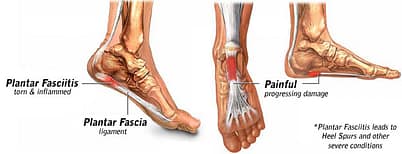
The condition is associated with repetitive strain from running, hiking, and sports like soccer. For some people, this type of injury is linked to occupation. For instance, if a person must stand for a long period of time on a hard surface, it could lead to plantar fasciitis. Dancers are also prone to this strain injury.
Research shows that people who have flat feet or high arches are more likely to suffer from plantar fasciitis. Those who are overweight or walk around in shoes that don’t have proper support are also at a higher risk of getting plantar fasciitis. For some reason, more elderly women seem to get this foot ailment.
While some people recover quickly from plantar fasciitis, others find the condition difficult to get rid of. Some people even have chronic plantar fasciitis.
Home Remedies for Plantar Fasciitis
An estimated two million Americans suffer from plantar fasciitis every year. It is the most common foot injury experienced by runners. The good news is that plantar fasciitis home remedies can help with healing.
If you find that one remedy doesn’t work, don’t get discouraged – keep trying and you’ll likely find a treatment that will ease at least some of your discomfort.
Here are the most common home remedies for plantar fasciitis:
- Cold compress: This can help reduce inflammation and pain. You can wrap a few ice cubes in a thin towel or freeze a plastic bottle filled with water. Place the cold compress over the painful area for a few minutes. Repeat this a few times a day. Don’t rub the ice directly on your heel.
- Rest: It’s a good idea to give your foot some rest. Avoid long walks or standing for too long. You should exercise a little to keep joints from getting stiff. Rest and ice for a couple of days is often the first line of treatment.
- Epsom salts: This is one of the most popular choices among all-natural home remedies for plantar fasciitis because it can be so soothing. It is also inexpensive. Epsom salt can relieve pain and inflammation. The salts can help heal muscles and connective tissues. You can add two to three tablespoons of Epsom salt to a tub of warm water and soak your foot for ten to fifteen minutes, twice a day.
- Apple cider vinegar: The medicinal properties of apple cider vinegar are said to reduce pain and inflammation. One tablespoon of raw, unfiltered apple cider vinegar and one tablespoon of raw honey can be added to a glass of warm water. You should drink this mixture a couple times a day. You can also add two tablespoons of apple cider vinegar to a tub of warm water and soak your foot for five to ten minutes.
- Acupuncture: Some people who don’t respond to exercises for plantar fasciitis turn to acupuncture. This traditional Chinese treatment can help with fascia pain. One study has demonstrated that treatment over a four-week period stimulating classic acupoints with needles provided significant relief from pain.
- Other remedies: Wearing shoes that can be laced-up and have moderate or low heels that support heels and arches is best. Wearing heels or flats are more likely to cause you problems. If you’re a runner, choose the right shoes and remember to change them after every 350 miles.
Some people find insoles that go inside shoes helpful in providing support for the foot and heel. Night splints can also be worn to help speed up recovery. They stretch the Achilles tendon and plantar fascia. In recent years, athletes have been using sports strapping tape to relieve pressure on their heels.
Lastly, a 2015 study showed that lavender essential oil has anti-inflammatory properties that could help with pain caused by inflammation. You can try diluting a couple drops of lavender oil in a carrier oil, such as olive or coconut oil, and massaging it into the bottoms of your feet. You can also add the oil to a warm foot bath.
Continue reading the full article from Bel Marra Health Bel Marra Health here.
 Skip to content
Skip to content
